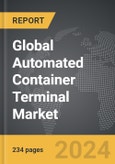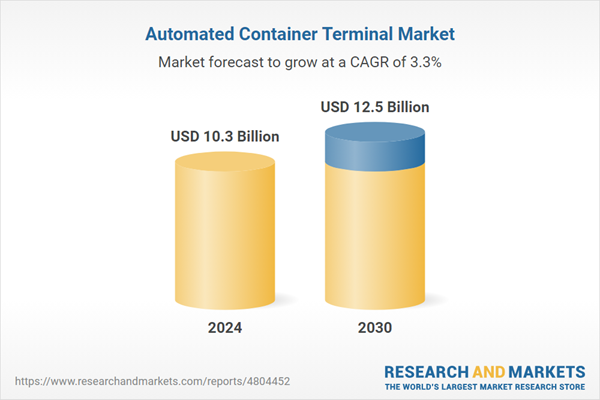Global Automated Container Terminal Market - Key Trends and Drivers Summarized
How Are Automated Container Terminals Revolutionizing Global Trade?
Automated container terminals are revolutionizing global trade by enhancing the efficiency, safety, and sustainability of port operations. These terminals leverage advanced technologies such as robotics, automated guided vehicles (AGVs), and crane automation systems to handle the movement of containers with minimal human intervention. This shift towards automation is driven by the need to accommodate the increasing volume of global trade while reducing operational costs and minimizing errors. Automated terminals operate 24/7, significantly improving throughput and reducing turnaround times for ships, which is crucial in an industry where time directly translates to money. Furthermore, automation enhances the safety of terminal operations by minimizing the risks associated with manual handling of heavy containers, thereby reducing workplace accidents. The environmental impact is also a key consideration, as automated systems are typically more energy-efficient and can be integrated with renewable energy sources, aligning with the global push towards greener logistics operations.What Role Does Technology Play in Advancing Terminal Automation?
Technology plays a pivotal role in advancing terminal automation, with innovations in robotics, artificial intelligence (AI), and the Internet of Things (IoT) driving the next generation of smart container terminals. Robotics and automation technologies are at the core of this transformation, enabling the development of automated cranes, AGVs, and automated stacking cranes (ASCs) that can perform complex tasks with precision and consistency. AI and machine learning are being integrated into terminal management systems to optimize the scheduling of container movements, predict maintenance needs, and enhance decision-making processes. IoT connectivity allows for real-time monitoring of terminal operations, providing data-driven insights that improve efficiency and reduce downtime. The integration of these technologies not only enhances the operational capabilities of terminals but also supports the scalability of automation solutions, making it feasible for ports of varying sizes to adopt automation. As these technologies continue to evolve, they are expected to further reduce the reliance on manual labor, enhance the accuracy of operations, and enable more dynamic and responsive terminal management.Which Market Trends Are Shaping the Adoption of Automated Container Terminals?
The adoption of automated container terminals is being shaped by several key market trends, including the growing demand for operational efficiency, the increasing complexity of global supply chains, and the rising costs of labor. As global trade volumes continue to expand, there is a pressing need for ports to increase their handling capacity without expanding their physical footprint. Automation provides a solution by maximizing the utilization of existing terminal space and resources. The complexity of modern supply chains, characterized by just-in-time delivery models and the need for real-time visibility, is also driving the demand for smarter, more integrated terminal operations. Automated terminals offer the precision and speed required to meet these demands, making them an attractive option for port operators. Additionally, rising labor costs and shortages of skilled workers in the logistics sector are pushing ports to invest in automation as a means of maintaining competitiveness and ensuring continuity of operations. These trends are creating a fertile ground for the expansion of automated container terminals, as they address the critical challenges faced by the industry.What Is Driving the Growth in the Automated Container Terminal Market?
The growth in the automated container terminal market is driven by several factors that are collectively advancing the adoption and development of these technologies. One of the primary drivers is the rapid increase in global trade volumes, which necessitates more efficient and scalable port operations. Technological advancements, particularly in robotics, AI, and IoT, are making automation more accessible and cost-effective, thereby encouraging more ports to invest in these systems. The need to reduce operational costs, particularly labor expenses, is another significant factor, as automation offers a long-term solution to the challenges posed by rising wages and labor shortages. Environmental sustainability is also playing a crucial role, with ports increasingly adopting automated systems to reduce energy consumption and emissions, in line with global environmental goals. Additionally, the increasing complexity and demand for real-time data in supply chain management are driving the need for more sophisticated and automated terminal operations. These factors, along with supportive government policies and investments in port infrastructure, are expected to sustain the growth of the automated container terminal market in the coming years.Report Scope
The report analyzes the Automated Container Terminal market, presented in terms of units. The analysis covers the key segments and geographic regions outlined below.Segments: Offering (Services, Equipment, Software); Degree of Automation (Semi-Automated, Fully Automated); Project Type (Greenfield, Brownfield).
Geographic Regions/Countries: World; United States; Canada; Japan; China; Europe (France; Germany; Italy; United Kingdom; Spain; Russia; and Rest of Europe); Asia-Pacific (Australia; India; South Korea; and Rest of Asia-Pacific); Latin America (Argentina; Brazil; Mexico; and Rest of Latin America); Middle East (Iran; Israel; Saudi Arabia; United Arab Emirates; and Rest of Middle East); and Africa.
Key Insights:
- Market Growth: Understand the significant growth trajectory of the Automated Container Terminal Services segment, which is expected to reach US$5.9 Billion by 2030 with a CAGR of a 3.5%. The Automated Container Terminal Equipment segment is also set to grow at 2.8% CAGR over the analysis period.
- Regional Analysis: Gain insights into the U.S. market, valued at $2.8 Billion in 2024, and China, forecasted to grow at an impressive 5.6% CAGR to reach $2.5 Billion by 2030. Discover growth trends in other key regions, including Japan, Canada, Germany, and the Asia-Pacific.
Why You Should Buy This Report:
- Detailed Market Analysis: Access a thorough analysis of the Global Automated Container Terminal Market, covering all major geographic regions and market segments.
- Competitive Insights: Get an overview of the competitive landscape, including the market presence of major players across different geographies.
- Future Trends and Drivers: Understand the key trends and drivers shaping the future of the Global Automated Container Terminal Market.
- Actionable Insights: Benefit from actionable insights that can help you identify new revenue opportunities and make strategic business decisions.
Key Questions Answered:
- How is the Global Automated Container Terminal Market expected to evolve by 2030?
- What are the main drivers and restraints affecting the market?
- Which market segments will grow the most over the forecast period?
- How will market shares for different regions and segments change by 2030?
- Who are the leading players in the market, and what are their prospects?
Report Features:
- Comprehensive Market Data: Independent analysis of annual sales and market forecasts in US$ Million from 2024 to 2030.
- In-Depth Regional Analysis: Detailed insights into key markets, including the U.S., China, Japan, Canada, Europe, Asia-Pacific, Latin America, Middle East, and Africa.
- Company Profiles: Coverage of players such as ABB Group, Camco Technologies, Cargotec Corporation, CyberLogitec, Identec Solutions AG and more.
- Complimentary Updates: Receive free report updates for one year to keep you informed of the latest market developments.
Some of the 22 companies featured in this Automated Container Terminal market report include:
- ABB Group
- Camco Technologies
- Cargotec Corporation
- CyberLogitec
- Identec Solutions AG
- Inform Software Corporation
- Infyz Solutions Private Ltd
- Konecranes
- Kunz GmbH
- Liebherr-International AG
- Loginno Logistic Innovation Ltd.
- Logstar
- ORBCOMM, Inc.
- Orbita Ports Terminals
- PACECO CORP.
- Shanghai Zhenhua Heavy Industries Co., Ltd. (ZPMC)
- Starcom Systems Ltd.
- Tidework Technology
- Total Soft Bank Ltd.
- World Crane Services
Tariff Impact Analysis: Key Insights for 2025
Global tariff negotiations across 180+ countries are reshaping supply chains, costs, and competitiveness. This report reflects the latest developments as of April 2025 and incorporates forward-looking insights into the market outlook.The analysts continuously track trade developments worldwide, drawing insights from leading global economists and over 200 industry and policy institutions, including think tanks, trade organizations, and national economic advisory bodies. This intelligence is integrated into forecasting models to provide timely, data-driven analysis of emerging risks and opportunities.
What’s Included in This Edition:
- Tariff-adjusted market forecasts by region and segment
- Analysis of cost and supply chain implications by sourcing and trade exposure
- Strategic insights into geographic shifts
Buyers receive a free July 2025 update with:
- Finalized tariff impacts and new trade agreement effects
- Updated projections reflecting global sourcing and cost shifts
- Expanded country-specific coverage across the industry
Table of Contents
Companies Mentioned (Partial List)
A selection of companies mentioned in this report includes, but is not limited to:
- ABB Group
- Camco Technologies
- Cargotec Corporation
- CyberLogitec
- Identec Solutions AG
- Inform Software Corporation
- Infyz Solutions Private Ltd
- Konecranes
- Kunz GmbH
- Liebherr-International AG
- Loginno Logistic Innovation Ltd.
- Logstar
- ORBCOMM, Inc.
- Orbita Ports Terminals
- PACECO CORP.
- Shanghai Zhenhua Heavy Industries Co., Ltd. (ZPMC)
- Starcom Systems Ltd.
- Tidework Technology
- Total Soft Bank Ltd.
- World Crane Services
Table Information
| Report Attribute | Details |
|---|---|
| No. of Pages | 234 |
| Published | April 2025 |
| Forecast Period | 2024 - 2030 |
| Estimated Market Value ( USD | $ 10.3 Billion |
| Forecasted Market Value ( USD | $ 12.5 Billion |
| Compound Annual Growth Rate | 3.3% |
| Regions Covered | Global |









